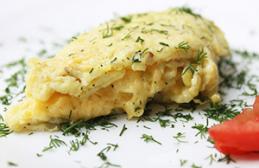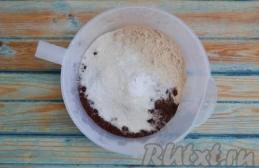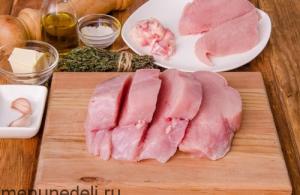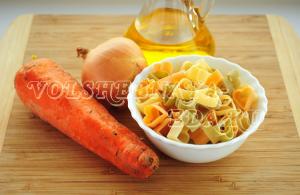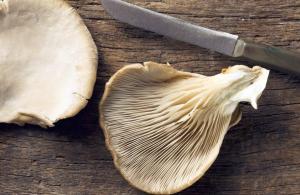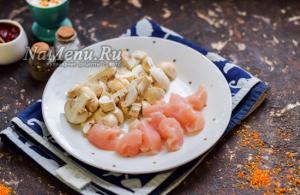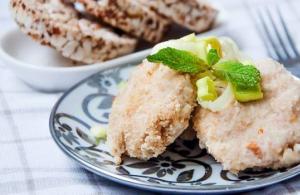Today, many people are switching to a healthy diet and giving up fried and fatty foods. This, of course, is correct, but how sometimes you want to pamper yourself with crispy potatoes, a juicy cutlet, and when you remember the fragrant pasties, the desire to forget about healthy foods and healthy eating completely awakens. Moreover, if there is a festive feast coming up, it is unlikely that your guests will be satisfied with steamed vegetables with lemon juice and boiled breast. Therefore, today we will talk about how to make it least harmful. This greatly depends on the quality of the product itself, the temperature to which it will be heated and also on the chosen oil. Let's do some research and find out which oil is best for frying.
What do we usually use in everyday life?
It will not be a secret that every housewife has a bottle of sunflower oil at home. It is used primarily for frying, added to dough, and seasoned on salads. However, the first criterion that formed the basis of this choice was the low cost and availability of this product. When talking about which oil is best for frying, you should remember that it is best not to use sunflower oil in your kitchen at all. The only option is to take a small bottle that smells like seeds and season salads, that is, use it without heating.
Choosing oil: what to look for?
We will wait a little longer to answer the main question about which oil is best for frying, because for this we need to deal with one more topic. Many of us were taught to focus on the smoke point. That is, the higher the temperature the oil can withstand before smoke appears above the frying pan, the less dangerous such frying is, which means that much fewer carcinogens will be formed. In fact, this is not true at all. We need to buy the oil that is the most stable, then there will be practically no danger from it. What does stable fat mean? That is, the likelihood of oxygen oxidation is minimal. When choosing which oil to fry in, be sure to pay attention to this point. Oxidation is a chemical reaction that produces free radicals and other harmful compounds.

Classification of fats
It's not as difficult as it might seem at first glance. There are only three types of fats, and therefore, when deciding which oil is best for frying, you must keep this in mind. The most unstable oils are polyunsaturated ones. They should not be used for heating or cooking food. This method will saturate your food with free radicals and increase the risk of developing various chronic diseases. This is primarily sunflower, rapeseed, corn, peanut, grape seed oil and some others.
The second type is monounsaturated fats. In principle, they are also unstable, and it is better not to heat them at all. The most famous representative of this species is olive oil. Very useful, but it should only be used cold. Finally, the last type is saturated fat. They are ideal for baking and frying and can easily withstand heat. This is butter and coconut, ghee and animal fat. If you choose from them which oil is best for frying, then the opinions of experts were distributed as follows. In first place is coconut oil. A completely atypical product for our stores, but it contains 90% saturated fat, that is, it is the most resistant to heat. But that is not all. It can remain fresh for up to two years and, in addition, contains a huge amount of useful substances. This oil is very multifunctional, so if you are thinking about which vegetable oil is best for frying, then this is the ideal option that will help you out more than once. Be sure to choose unrefined, organic oil. The second option suitable for heating is palm. Choose unrefined organic red oil.

Refined or natural
There are quite a lot of disputes on this topic. Both one and the other have their advantages. Refined food has no taste or smell, but there are no beneficial substances left in it. The only plus is that unrefined requires a higher temperature, which means it takes a little longer to reach the smoke point. However, as already mentioned, this does not guarantee that your food is free of carcinogens. Unrefined oil has a bright aroma and taste, which means your dishes will be especially tasty. But it doesn’t like heat even more than the purified one.
Healthy French fries
In fact, this is nonsense; if you want healthy potatoes, mash them or bake them in a sleeve. But you can somewhat reduce the harm of this tasty dish, and then the question arises about what oil is better to fry potatoes in. Choose coconut or palm oil; if this is not on sale, then it is better to stick with cracklings or animal fat. You won’t get a lethal dose of cholesterol, and your body will accept such a dish much better.
When frying with unrefined sunflower oil, acrylamide is formed - a dangerous substance. Therefore, if the choice of vegetable fats is very limited, then give preference to olive oil or, as a last resort, refined sunflower oil. But add it a little so that only the potatoes do not burn. We think it’s already clear without additional comments which olive oil is best for frying; you should use only refined oil.

Meat and fish
Fried meat is very tasty, although it is not the healthiest food. On the other hand, this is precisely the product that requires long-term heat treatment, which means that the question of which oil is best to fry meat in has no answer at all. Any vegetable oil, when heated for long periods of time and at high temperatures, will become a source of carcinogens. So do it another way. Make the marinade by adding a small amount of oil, but it doesn’t really matter what it is. The meat will absorb it - and you can fry it either on the grill or in a dry frying pan.
Speaking about which oil is best to fry fish, I would like to quote the advice of experienced chefs: it is best to sprinkle the fish with lemon and olive oil, and then bake it in a sleeve.

Cutlets
Juicy and tender, these meat balls are the most common second course. But what oil is better to fry cutlets in is not the easiest question. The fact is that the cooking technology requires heating the frying pan to maximum. Due to this, the crust quickly sets and all the juice remains inside. At the same time, in order not to harm your health, it is better to do without vegetable oil, replacing it with melted and well-heated fat.

Dough products, pasties and pies
When choosing which oil is best to fry pasties, do not forget that you need to change it every time after preparing the next portion. You cannot use deep fat fryer many times in a row. An ideal option would be a mixture of beef and lard with the addition of lard. However, if it is possible to use it completely, it is better to use it.

So, the most popular today are olive, sunflower and flaxseed oils. Almost no one uses the latter for frying, which means we are left with two “candidates” for the title of the most harmful. Olive oil needs to boil much longer for harmful substances to begin to form. And experienced chefs advise pouring a little water into the frying pan before frying, then add all the ingredients and finally add oil. You can try another option: fry in a dry frying pan, adding oil only at the end of cooking. And don’t forget to choose good non-stick cookware, because we add oil precisely so that food does not stick to the surface.
Sometimes we don’t have enough time to think about everyday little things, which are nevertheless very important. But still, sometimes every housewife, while shopping in the supermarket, thinks about what oil is better for frying?
Which oil do we choose?
When making a choice in the store, we try to choose odorless, tasteless, cholesterol-free, and cheaper frying oil. This is what many housewives do. But which oil is better and more correct for frying? Let's take a closer look at the nuances.
Currently, there is a fairly large selection of vegetable oils that are used for cooking. But it is worth noting that not all of them are suitable for frying. Now there are a variety of opinions regarding which oil is healthier for frying. There is heated debate surrounding this issue.
Recent research by scientists in Europe has shown that it is absolutely not worth using linseed oil for heat treatment. The fatty acids contained in it, when heated, turn into trans fats, which are very harmful to human health, as they can lead to the development of malignant diseases. You can fry in corn, sunflower, mustard or olive oil. Nutritionists strongly recommend frying in oil that has the highest boiling point. From a medical point of view, this is the most acceptable option. These oils include: palm, olive, soybean, corn. Their boiling points are as follows: soybean, corn - 180 degrees, sunflower - 120-140 degrees.
What are the benefits of oils?
When talking about which oil is better and healthier for frying, it is worth noting that you can find an incredible variety of similar bottles on store shelves. But how are they different? If you look closely, you can see the following inscriptions: “rich in vitamin E,” “cholesterol-free,” “hydrated,” “frozen.” It is difficult for an ordinary consumer to understand such nuances.
According to knowledgeable experts, the most beneficial thing about vegetable oil is its valuable fatty acids. Each of them contains all three types: polyunsaturated, monosaturated and saturated. The difference lies only in the ratio of proportions.
Saturated acids are needed by the human body in small quantities. Their excess can lead to disruption of cholesterol and fat metabolism, which leads to atherosclerosis and coronary heart disease. There are a lot of saturated acids in peanut, coconut and palm oils.
But unsaturated acids (fatty acids), on the contrary, are extremely useful; they regulate metabolic processes in the human body. Nowadays there is a lot of talk around polyunsaturated acids: omega-6 and omega-3. According to recent studies, they not only prevent the development of atherosclerosis, but also contribute to the destruction of existing plaques on the walls of blood vessels. Such acids are simply irreplaceable for humans, since the body does not know how to produce them on its own, which means it can only be obtained through food. The main source is vegetable oil.
What determines the usefulness of oil?
Following traditions, we choose oil for frying from the usual list - sesame, sunflower, corn, but at the same time we completely ignore rapeseed, linseed, and walnut oil. According to doctors, such a imbalance cannot be called correct, since it affects health. Therefore, you should not limit yourself to just one type of oil.

As you know, the beneficial properties of a product depend on the raw materials. But a lot depends on the methods of extraction and cleaning. For example, vitamin E, which manufacturers talk about, is quite stable, but the less heat treatment, the more of it will be retained in the product.
Scientists believe that the most “living” oil, which contains the maximum amount of biologically active substances, is obtained using the cold pressing method. The labels of such products usually contain the inscription “cold press or first spin.” This oil only undergoes filtration to remove mechanical impurities.
The question arises: is it possible to fry with cold-pressed oil? The answer is obvious. Such a product consists of 70-80 percent monosaturated fatty acids, and to be more precise, linoleic and oleic acids. The beneficial properties of such acids are lost at temperatures above 90-120 degrees. And when frying, the temperature in the frying pan reaches 190-250 degrees. By cooking with cold-pressed oil, you kill the beneficial properties of the product and add very dangerous carcinogens to the food.
Types of oil processing
The delicate oil containing a large amount of polyunsaturated acids smokes very much in a frying pan and does not tolerate sunlight. But there is also a very good way to process the product, called extraction (organic solvents are used). According to experts, such oil goes through many stages of purification, but most of the beneficial substances are lost. To increase the shelf life of unrefined products, oils can be treated with alkali. The taste of such a product is no longer so bright, the color is more faded, and some of the beneficial substances are lost. But there are also useful points. For example, all pesticides and heavy metals that may be present in the raw materials are removed.
Well, refined oil is practically impersonal: it has no smell and is completely light. If it has also been deodorized, then we can say for sure that the fatty acids in it are partially preserved, but the vitamins and valuable substances are practically lost. Although most housewives prefer refined oil for cooking due to the lack of odor.
You can also often find the words “frozen” on labels. What does this mean? And this means that waxes have been removed from such a product. For this reason, at low temperatures, for example in the refrigerator, the oil begins to become cloudy and does not look its best. At the same time, it can be either refined or unrefined. It is worth noting that for all its advantages, refined malo is not very suitable for frying, as it burns and smokes. Ideally, when deciding which oil is best for frying, you should give preference to rapeseed, sunflower and olive.
Types of oils
To understand which oil is healthier for frying, you need to understand how well a particular product tolerates the heating process. The most important property in this matter is how easily the oil turns bitter and oxidizes during heat treatment. When it oxidizes, it becomes harmful. Therefore, the lower the oxidation temperature, the less suitable the oil for frying. This important parameter for this product is also called the smoke point. It is when it is reached that oxidized substances become extremely harmful.

Coconut oil
This oil consists of 92% saturated fatty acids, and therefore it is very resistant to heat. Its smoke point is between 172-230 degrees. At room temperature, it has a semi-soft consistency and does not go bitter for months, remaining fresh. In addition, the oil contains beneficial lauric fatty acid. There is evidence that it helps keep pathogenic bacteria under control and improves cholesterol profile. If you compare different types of oils, coconut oil gives you a feeling of fullness for a longer period. It is worth choosing an organic, cold-pressed product.
Ghee or butter
Previously, it was believed that frying in butter was very harmful. It is useful not only fresh, but also suitable for frying. In addition, it contains vitamins E and A, linolenic acid, which affects the process of weight loss and reduces inflammatory processes. Butter contains 68% saturated fat and 28% monounsaturated fat, with a smoke point between 120-150 degrees. But still it has one drawback. Regular butter contains proteins and sugar, which quickly burn on fire and turn black. To avoid such an unpleasant moment, you need to fry over very low heat or use purer ghee (Indian oil).

You can purchase it or prepare it yourself. To do this, good butter (homemade, from cows that ate grass, not animal feed) is melted over very low heat, and then gradually brought to a boil. First, the water evaporates from the mixture, then the protein and sugar darken and stick together, and the butter becomes dark golden brown. It is at this moment that the solution must be removed from the heat and strained using gauze. Sugar and protein remain in gauze, and pure oil is poured into a jar. The process itself is not too troublesome, but the result is worth it.
Olive oil
Many chefs are convinced that you should not fry in olive oil. And all its beneficial properties turn into harmful ones during the heating process. However, this is not entirely the correct opinion. Only 14% of the oil is saturated fat, but its smoke point is quite high: 200-240 degrees, depending on the degree of purity. Therefore, you can fry in olive oil. The famous chef Jamie Oliver in his popular blog recommends not only frying in unrefined olive oil, but also using it for deep frying. The maestro even advises generously pouring oil into the pan and using it repeatedly.

According to researchers, although most of the fatty acids in olive oil are unsaturated, this product is still resistant to oxidation when heated. But it should only be first and cold pressed oil.
The best high-class product Extra Virgin (first press) retains the maximum amount of beneficial properties. This oil is best used as a salad dressing. Its heating temperature allows you to fry foods with a high water content, such as vegetables. They are cooked at a temperature of 130-140 degrees. Products cut into pieces, eggs, meatballs, potatoes, dishes in batter or breading are also fried at a temperature of 160-180 degrees. Therefore, they can also be fried in this oil.

But refined olive oil is more suitable for frying food at high temperatures (230-240 degrees Celsius). Dishes that have a crispy crust are already harmful to health. After all, you can also stew, bake and steam foods; they are healthier.
Palm oil
There are a lot of rumors about palm oil. However, it consists of saturated fatty acids, and therefore tolerates high temperatures (230 degrees). The best option is red oil - unrefined, cold-pressed, the smoke point of such a product is not inferior to coconut oil. It also contains a lot of vitamin E. The main problem is the fact that such oil is produced on an industrial scale, and therefore it is difficult to find out what quality it is imported to us.
Rapeseed oil
Cold-pressed rapeseed oil has a good ratio of fatty acids, and the smoke point is quite high (190-230 degrees). Finding a similar product in stores is not easy. But refined hot-pressed rapeseed oil is chemically processed, and therefore there is no need to talk about its usefulness. But still it is considered quite good.
According to nutritionists, fried foods are inherently harmful. You can afford it only occasionally. But if you still sometimes think about what kind of oil to fry potatoes in, then high-quality olive oil is quite suitable. But you cannot use a mixture of it with sunflower. In addition, you can use any oils that can withstand high temperatures.
But no matter what type you choose, you should still be careful to ensure that the oil does not burn in the pan, forming harmful carcinogens.

Very often housewives prepare meat dishes. And they ask questions about what oil to fry cutlets, chops, and meatballs in. And again, the choice must be made towards oils that are resistant to temperatures (olive, coconut). But nutritionists, for their part, do not recommend mixing vegetable and natural fats. So the choice is yours. In addition, experts do not advise purchasing cheap olive oil (90 rubles) in supermarkets. This product is made from mixtures. A quality product costs from two hundred rubles.
Is it possible to fry without oil?
Currently, the market is saturated with all kinds of cookware that allows you to cook without oil. This method of preparation is more dietary and is recommended by doctors. In which pan can you fry without oil? If you plan to cook healthier food, then it is worth purchasing a frying pan or sauté pan with a ceramic or Teflon coating. Having an expensive, quality frying pan can help you cook healthier and reduce the use of frying oils.
Instead of an afterword
In our article, we tried to discuss the main types of oils that are considered the most suitable for frying. We hope we have helped you understand the rather complex issue of which oil is best for frying.
Choosing the ideal oil for frying
I have already written a lot and in detail. In addition, we found out which ones are healthier from the point of view of “deliciousness”.
But since frying is one of the favorite culinary techniques not only in ours, but also in most cuisines of the world, I think it’s time to figure out which fat is better to fry with. To do this, let’s remember what frying is and at what temperature it is carried out.
Frying (roasting) – This is the thermal treatment of products using heated fat, but without adding water or any other liquid containing water. This process is carried out at a temperature of about 180°C in order to form a tasty crispy crust on the surface of the product, which is the result of the breakdown of organic substances in food under the influence of high temperature and the formation of new ones.
That is, we understand that a delicious golden crust is formed at approximately 180 0C. However, it begins to form at the temperature at which the chemical reaction between amino acids and sugars begins (Maillard reaction temperature) - about 140-165 degrees, at a lower temperature the product will be stewed, that is, water will simply evaporate from it.
This temperature should be taken into account when you cook and select an oil that does not start smoking at the temperature you need. For example, if you fry vegetables, fish or an omelet, for which a small fire is enough, then even an oil with a low smoke point is suitable, but for meat and poultry it is better to choose an oil with a maximum smoke point.
Smoke point of various fats
|
Vegetable oil |
Smoke point 0C |
|
Unrefined canola oil |
|
|
Unrefined flaxseed oil |
|
|
Unrefined safflower oil |
|
|
Unrefined sunflower oil |
|
|
Unrefined corn oil |
|
|
Unrefined high-oleic sunflower oil |
|
|
Extra virgin olive oil |
|
|
Unrefined peanut oil |
|
|
Semirefined safflower oil |
|
|
Unrefined soy oil |
|
|
Unrefined walnut oil |
|
|
Hemp seed oil - Hemp seed oil |
|
|
Butter |
|
|
Semirefined canola oil |
|
|
Coconut oil |
|
|
Unrefined sesame oil |
|
|
Semirefined soy oil |
|
|
Vegetable shortening |
|
|
Macadamia nut oil |
|
|
Refined canola oil |
|
|
Semirefined walnut oil |
|
|
Ghee butter (GHI) |
|
|
High quality (low acidity) extra virgin olive oil |
|
|
Sesame oil - Sesame oil |
|
|
Cottonseed oil |
|
|
Grapeseed oil |
|
|
Virgin olive oil |
|
|
Almond oil |
|
|
Hazelnut oil |
|
|
Peanut butter |
|
|
Sunflower oil |
|
|
Refined corn oil |
|
|
Palm oil |
|
|
Palm kernel oil |
|
|
Refined high-oleic sunflower oil |
|
|
Refined peanut oil |
|
|
Refined Safflower oil |
|
|
Semirefined sesame oil |
|
|
Refined soy oil |
|
|
Semirefined sunflower oil |
|
|
Olive pomace oil |
|
|
Clarified refined olive oil - Extra light olive oit |
|
|
Refined soybean oil - Soybean oil |
|
|
Avocado oil |
And now I offer you the TOP 5 best fats for frying.
Looking at the table, you would think that the oils with the highest smoke point would be the best for frying. But not everything is like that  Just! The most “smoke-resistant” avocado oil, for example, is not only scarce, where you can buy it, and it’s not cheap, but there’s no point in frying with it - we’ll lose the taste and benefits completely.
Just! The most “smoke-resistant” avocado oil, for example, is not only scarce, where you can buy it, and it’s not cheap, but there’s no point in frying with it - we’ll lose the taste and benefits completely.
But the most popular refined sunflower and corn oils, although they have smoke points of 227 and 232 0C, respectively, I won’t include in our TOP at all, they contain too many omega-6 fatty acids, which we already consume in excess.
When compiling the TOP 5, I thought for a long time about which fat to give the palm to, because the winner should be not only healthy, but also affordable. And a dilemma emerged: if we proceed from the usefulness of fat during frying, then coconut oil would win. But where are we, and where is the coconut oil? Both in price and availability... However, I won’t even include cheap and widely used palm oil in my TOP. And not because there is so much conflicting data about it, although palm oil, consisting mostly of saturated fatty acids, can withstand heat with dignity, the smoke point is 232 degrees (that is, even higher than coconut oil). But because the oil that is supplied to us is of unknown quality, it is unlikely that high-quality red palm oil will be brought here. And besides, so much palm oil is now added to our food products, even to those that we don’t even suspect, that even frying with them means eating almost nothing but palm oil.
Therefore, the first place was shared by two types of fat, and let my fellow nutritionists forgive me, both of these fats are animal: butter (albeit melted butter, GHI or GI) and lard. Yes, yes, they are the ones who combine benefit and accessibility for our compatriots.
 But in fairness, I’ll still start with the real “winner” - on which, perhaps, the whole of Southeast Asia is roasting. However, it is also almost “animal”, because its composition is closer to animal fats, it consists of 92% saturated fatty acids, and therefore is very resistant to heat. The smoke point, depending on the variety, is from 177 to 230 0C. At room temperature it is semi-soft and does not go rancid for quite a long time. Coconut oil contains a unique complex of fatty acids, including saturated lauric acid, which our body converts into monolaurin, which fights viruses and bacteria that cause herpes, influenza, HIV, listeriosis and giardia. Although coconut oil is more than 90% saturated fat, most of which is medium chain triglycerides, lauric acid is the main factor in its absorption. It is because of this that coconut oil, compared to other oils, gives you a feeling of fullness for a longer period.
But in fairness, I’ll still start with the real “winner” - on which, perhaps, the whole of Southeast Asia is roasting. However, it is also almost “animal”, because its composition is closer to animal fats, it consists of 92% saturated fatty acids, and therefore is very resistant to heat. The smoke point, depending on the variety, is from 177 to 230 0C. At room temperature it is semi-soft and does not go rancid for quite a long time. Coconut oil contains a unique complex of fatty acids, including saturated lauric acid, which our body converts into monolaurin, which fights viruses and bacteria that cause herpes, influenza, HIV, listeriosis and giardia. Although coconut oil is more than 90% saturated fat, most of which is medium chain triglycerides, lauric acid is the main factor in its absorption. It is because of this that coconut oil, compared to other oils, gives you a feeling of fullness for a longer period.
Having been “persecuted” by nutritionists for so long, it is regaining its rightful position by returning to the diet.  healthy and sick people. Natural butter is very beneficial for skin, hair, vision, bone and muscle tissue. It contains vitamins A, D, E, C, B, calcium, phospholipids (building material for cells, especially nerve cells) and essential amino acids. The oil normalizes digestion, heals ulcers in the stomach and duodenum, cures some skin diseases, colds, bronchial and lung diseases, and even such a terrible disease as tuberculosis.
healthy and sick people. Natural butter is very beneficial for skin, hair, vision, bone and muscle tissue. It contains vitamins A, D, E, C, B, calcium, phospholipids (building material for cells, especially nerve cells) and essential amino acids. The oil normalizes digestion, heals ulcers in the stomach and duodenum, cures some skin diseases, colds, bronchial and lung diseases, and even such a terrible disease as tuberculosis.
But it is still not recommended to use it for frying, although its smoke point is 177 0C. And all because it foams, splashes and quickly turns black when heated, because pure butter contains a small amount of sugars and proteins, which quickly burn on fire and turn black when frying in a hot frying pan. Although I remember very well the taste of scrambled eggs in butter - throughout my childhood, first my mother, and then I myself, fried eggs this way.
It does not have these shortcomings, which is quite accessible to anyone - you can buy it or prepare it yourself. GCI, in fact, is almost 99% fat (which includes up to 36% polyunsaturated fatty acids combined with vitamins A, E and D), and the remaining 1% is milk proteins and carbohydrates. Ghee oil is considered the most useful for cooking, as it promotes its absorption and removal of food residues from the body, protects our body from the harmful effects of free radicals, is an ideal source of fatty acids, and also improves complexion as a “bonus”.
 Next to the melted butter I will put a product that is loved by many -. However, it is still better suited for frying. lard
- fat rendered from lard. It, like GCI, contains no protein residues or “extra” water. However, it’s also very good to fry with regular lard, considering the smoke point is 182 0C.
Next to the melted butter I will put a product that is loved by many -. However, it is still better suited for frying. lard
- fat rendered from lard. It, like GCI, contains no protein residues or “extra” water. However, it’s also very good to fry with regular lard, considering the smoke point is 182 0C.
The only “but” for both butter and lard is that the composition of their fatty acids largely depends on the animal’s diet. Ideally, buy butter and lard from familiar sellers and manufacturers whose pig cows graze in the meadows, then their fat will contain more saturated and monounsaturated fats and less polyunsaturated omega-6, which, I repeat, we already eat too much.
Next I would put olive oil. But, I'm afraid, both my colleagues and even many  the chefs will raise their eyebrows in surprise and even say “ugh”. Because many are sure that olive oil should be eaten exclusively raw, ideally high quality (low acidity), first pressed - High quality (low acidity) extra virgin. I don't mind! Part of the famous Mediterranean diet, recognized by UNESCO as a World Heritage of Humanity, this oil is best eaten in salads and other dishes without heating. However, the entire Mediterranean region has been frying with this oil for thousands of years. And the smoke point of olive oil, depending on the quality and degree of purification, ranges from 160 0C for extra virgin olive oil to 238 0C for olive pomace oil and 242 0C for clarified refined olive oil (Extra light olive oit). And do not believe that olive oil becomes almost poisonous when heated, otherwise the Mediterranean civilization would have died out thousands of years ago, barely born. Despite the fact that most of the fatty acids in olive oil are unsaturated, it is very resistant to oxidation when heated. One piece of advice: choose an oil with minimal acidity - ideally 0.3 or less. And by the way, even one of the most famous restaurateurs and chefs, Jamie Oliver, uses olive oil everywhere, even for deep-frying! I once came across this recipe from him: pour a thick layer of oil into a frying pan, heat it up, break an egg and fry, carefully turning it over with a spoon or slotted spoon. The end result is something like a poached egg.
the chefs will raise their eyebrows in surprise and even say “ugh”. Because many are sure that olive oil should be eaten exclusively raw, ideally high quality (low acidity), first pressed - High quality (low acidity) extra virgin. I don't mind! Part of the famous Mediterranean diet, recognized by UNESCO as a World Heritage of Humanity, this oil is best eaten in salads and other dishes without heating. However, the entire Mediterranean region has been frying with this oil for thousands of years. And the smoke point of olive oil, depending on the quality and degree of purification, ranges from 160 0C for extra virgin olive oil to 238 0C for olive pomace oil and 242 0C for clarified refined olive oil (Extra light olive oit). And do not believe that olive oil becomes almost poisonous when heated, otherwise the Mediterranean civilization would have died out thousands of years ago, barely born. Despite the fact that most of the fatty acids in olive oil are unsaturated, it is very resistant to oxidation when heated. One piece of advice: choose an oil with minimal acidity - ideally 0.3 or less. And by the way, even one of the most famous restaurateurs and chefs, Jamie Oliver, uses olive oil everywhere, even for deep-frying! I once came across this recipe from him: pour a thick layer of oil into a frying pan, heat it up, break an egg and fry, carefully turning it over with a spoon or slotted spoon. The end result is something like a poached egg.
 I would give fifth place. It has a good ratio of omega-6 to omega-3 - approximately 2:1, but where have you seen it on sale here? I myself saw and tried rapeseed oil (canola oil) for the first time quite recently in Israel; by the way, fish and vegetables fried in it had a taste different from those fried in other types of vegetable oils and were reminiscent of fried in butter. So, if you see a bottle of oil with small yellow flowers in the supermarket, don’t hesitate to grab it!
I would give fifth place. It has a good ratio of omega-6 to omega-3 - approximately 2:1, but where have you seen it on sale here? I myself saw and tried rapeseed oil (canola oil) for the first time quite recently in Israel; by the way, fish and vegetables fried in it had a taste different from those fried in other types of vegetable oils and were reminiscent of fried in butter. So, if you see a bottle of oil with small yellow flowers in the supermarket, don’t hesitate to grab it!
But based on everything said above, we didn’t even get the TOP-5... Coconut oil is rare and expensive, rapeseed oil is even rarer, olive oil is also not cheap... Most nutritionists are up in arms against lard and butter (but I’m not one of them numbers!). The usual sunflower and corn oils remain. If we take their composition and benefits, then they are very far from ideal, because they contain too many Omega-6 fatty acids and practically no Omega-3. But they still remain the most accessible to our consumers. Therefore, “in the absence of stamped paper, we write on plain paper,” that is, we use them for frying. But I want to give some tips on minimizing the harm from these oils:

- fry more or less quickly in a frying pan
- we carry out a long, slow frying process in a cauldron, stewpan, cauldron - in a deep bowl, and in a deeper layer of oil
- Extra-fast frying is carried out in a deep container (eg deep fryer) and in a large amount of boiling oil.
A thickened bottom is the main requirement for frying utensils. It is not advisable to fry in a container with a thin bottom.
Many people love fried food. Of course, this is not the healthiest food, but how healthy or harmful it will be largely depends on the oil in which we fry.
WHAT OIL IS BETTER TO FRY WITH?
This article will discuss which oil is best for frying in terms of health benefits.
How to fry to reduce harm to a minimum?
What kind of oil can you fry with and what kind of oil should you absolutely not fry with?
Why is frying in oil harmful?
- Calorie content of fried food. Fried foods absorb a lot of oil, which makes them very high in calories.
- Destruction of useful substances. At high temperatures, many beneficial substances are destroyed.
- Toxic products of fat breakdown. Many oils are destroyed when exposed to high temperatures and form extremely harmful carcinogenic substances: ketones, peroxides and aldehydes.
And yet, this is not a death sentence for your favorite fried potatoes! Fried food may not be nearly as harmful if it is not used!
How to fry in oil to make fried food healthier?
Why is it better to fry in oil with a high smoke point?
What oil should you not fry with: SOYBEAN OIL
The smoke point of unrefined soybean oil is 160 degrees. It contains 15% saturated fat (which is not bad), but more than 60% polyunsaturated fat. Frying in soybean oil is slightly more harmful than frying in corn oil. In general - not recommended.
What oil should not be used for frying: GRAPE SEED OIL
The smoke point of unrefined grape seed oil is 205 degrees, which is why it is often suggested for use in cooking. However, it contains more than 70% of the most susceptible to destruction of polyunsaturated fats.
Can I fry with grape seed oil? It’s not as harmful as rapeseed or sunflower, so it’s possible. But why? Unrefined grape seed oil is not the cheapest. For the same price, you can choose a much safer oil from the list.
What oil should you not fry with: PALM OIL

Most housewives have long realized that frying, stewing and baking with natural oils is much more profitable and tastier. But which one should you choose for each type of cooking? There are many varieties of vegetable oils that are used as food. However, not all oils can be used for frying.
Recent studies by European scientists have shown that under no circumstances should you fry with linseed oil. The fact is that during the frying process, the fatty acids contained in flaxseed oil are converted into trans fatty acids, which are very dangerous to health.
These substances can provoke the development of cancer and digestive disorders.
It is best to fry in sunflower, corn, mustard or olive oil. Some nutritionists recommend frying in oil with the highest boiling point. From a medical point of view, of course, and not from a culinary point of view. This includes palm oil, but it is more common to fry it with olive oil, corn oil or soybean oil (but special ones for frying). Their boiling points are: sunflower - 120-140, olive - 160, corn, soybean - 180.
1.
When frying, we use oils with a high combustion temperature and low fat content.,
for example oils such as avocado oil, sunflower oil, corn butter, peanut oil, rapeseed oil, sunflower oil
2
.
When stewing, we use any low-fat oils., such as rapeseed oil, avocado oil , safflower oil, corn oil, olive oil, walnut oil, peanut butter
3
.
We add any oils to salads,
both refined and unrefined,
but low in fat
Butter
Let's start the conversation with fat, which can replace sandwich margarines - spreads. Nutritionists believe that there is no better solid fat for humans than butter. Milk fat, they say, is an extremely healthy product, indispensable in the diet of most people, including those who suffer from cardiovascular diseases. Milk fat is especially useful for children whose digestive, immune and endocrine systems have not yet become stronger, as well as for people with diseases of the liver and biliary tract. Any Frenchman will tell you that it is tastiest to fry in plain butter. This is one of the main "secrets" of French cuisine.
Unlike spreads, butter contains many biologically active substances useful for humans: vitamins (A, beta-carotene - provitamin A, E, D), micro- and macroelements, phospholipids, lecithin, sterols, etc. And since during the production of butter Milk fat is not exposed to high temperatures; these substances are in an active state.
Butter contains cholesterol, which many people fear. However, in a daily serving of oil (25-30 g) there is only about 50 mg. And in small quantities, it is vitally necessary for the body to maintain the structure of cell membranes, the synthesis of steroid hormones, and immune cells that protect the body from pathogenic microbes.
It is better to consume butter in its natural form, spreading it on bread, cookies, pastries, adding to cereals and other ready-made dishes. Nutritionists do not recommend cooking, let alone frying, with butter, since even short-term high-temperature heating significantly reduces its biological value. The oil has emollient properties and has a calming effect on irritated mucous membranes. Therefore, medicine in the form of warm milk, honey and butter is an excellent remedy for sore throat.
Now butter is 90% fake. Pay attention to the labels. If the butter has some name - “Kremlin”, “Smolensk”, “Vologda”, etc. - It’s better not to buy this. “Kremlevskoye,” for example, is a bad margarine.
Among the trusted manufacturers, these are Prostokvashino, Vesely Milkman, Summer Day, Anchor, and Domik v Village oils. The standard designation for butter is GOST 37-91. The date of manufacture and expiration date must be clearly printed and easy to read. When heated to a temperature of 100 degrees, the oil loses all its beneficial properties. It turns into unhealthy fat. But if you melt the butter without heating it too much and pour it over the dish, it will not only be tasty, but also healthy.
Melted butter
Ghee cow butter is not only a universal fatty product for culinary products, which is good for frying cheesecakes and scrambled eggs, baking pies and other delicacies. It also has medicinal properties: it stimulates digestive processes, in particular improves the functioning of the small intestine, has a beneficial effect on the liver, and nourishes the brain.
In Russia, melted butter has always been a popular fatty product and was produced in significant quantities. Nowadays it is rarely found in stores, but it is not difficult to prepare it yourself.
How to prepare ghee. Place the butter in a saucepan (preferably stainless steel) and melt over low heat. When the butter is melted, reduce the heat to low, ensuring that only a few bubbles rise from the butter. These bubbles form foam, which must be periodically skimmed off with a spoon until the oil becomes transparent and vegetable-like in color, and a dark brown sediment forms at the bottom of the pan. Pour the finished oil through a strainer into a clean glass container, cool and seal. High-quality ghee should be yellow in color, have the smell and taste of milk fat and have a fine grainy consistency.
The process of preparing ghee takes about two hours. The amount of product obtained depends on the fat content of the melted cow butter. From 1 kg of butter with 72.5% fat content, about 600 g of ghee is usually obtained, and from butter with 82.5% fat content - about 800 g. The resulting butter can be stored for up to a year in a dark place at a temperature of 2 to 6 ° WITH.
Pork fat
A good alternative to synthetic fats is lard. Our ancestors fried and stewed on it; rendered pork fat was added to the dough for pies and other baked goods.
Modern scientists have proven that moderate heating of pork fat is not harmful - when melted, its biological properties and digestibility only improve. You can not only fry it, but also simply eat it. Moderately salted lard, with black bread and garlic, is not only tasty, but also healthy.
Unlike other animal fats, which consist mainly of saturated fatty acids, pork fat contains many beneficial unsaturated fatty acids, including arachidonic acid, which is rarely found in our diet. The ratio of saturated, mono- and polyunsaturated acids in it is approximately 4:5:1, which is quite close to the optimal - 4:6:1.
Modern scientists believe that pork fat is one of the most complete among vegetable and animal fats. In terms of biological activity, it is 5 times superior to butter.
Short-term heating of fat when frying foods increases the digestibility of refractory fats - beef and lamb, does not change the digestibility of lard and reduces the biological value of vegetable oils and butter. In this regard, ghee and lard should be used for frying. With prolonged heat treatment, not only the destruction of biologically active substances contained in fats occurs, but also the formation of toxic products of fatty acid oxidation. With repeated heat treatment, oils become carcinogenic.
So, the quality of beef and lamb fat improves when heated, vegetable oils deteriorate, and when pork fat is heated, nothing happens to it.
Vegetable oil
You can cook food not only with milk and pork fat, but also with vegetable oil, which has a high smoke point. This is what experts call the temperature at which oil heated in a frying pan begins to smoke. It is impossible to cook food in oil with a low smoke point: it produces many products of high-temperature oxidation of polyunsaturated fatty acids that are harmful to humans.
Ideal for cooking are olive, grape and high-oleic sunflower oils - all of them consist mainly of oleic acid, which is fairly heat-resistant.
In principle, it is possible to fry in unrefined vegetable oil: sunflower, corn, etc., but only at a moderate temperature (150-170°C), which should not be exceeded. The fact is that they contain a lot of polyunsaturated fatty acids, which, when heated above 180°C, begin to intensively oxidize with the formation of peroxides, ketones, aldehydes and other chemical compounds, which not only give the product an unpleasant taste and smell, but are also toxic substances, adversely affecting human health.
Palm oil can be a good alternative to hydrogenated cooking fats. In our country it is currently used mainly in the food industry, but it is also quite suitable for home use. You can fry, bake, and season salads with it.
Like lard, palm oil is composed primarily of the heat-stable fatty acids saturated palmitic and monounsaturated oleic, so it can withstand temperatures that would cause most other oils to smoke and break down.
In addition to high thermal stability, palm oil has other advantages. To begin with, benzene and other organic solvents are not used in its production, so it is environmentally friendly. Further. Products fried in palm oil have a beautiful golden color. In addition, palm fat has the ability to retain tiny air bubbles on its surface, giving the finished product a delicate taste and friability. Therefore, they not only fry with palm oil, but also add it to the dough for cookies, cakes, muffins and other confectionery products.
Despite its excellent consumer properties, palm oil until recently was considered by many, and some continue to be considered, almost the worst vegetable oil due to its high content of palmitic acid. There is really a lot of this atherogenic fatty acid in palm oil - about 50%. However, in the world of fats, not everything is so simple. Biochemist scientists have proven that the nature of their effect on the human body depends on the location of saturated fatty acids in triglyceride molecules (in fat molecules). In palm oil, a significant part of palmitic acids is in the second, so to speak, position that is not harmful to human health. It is interesting to note that the same position in the fat molecule is occupied by part of the palmitic acids found in cow's milk.
Experts from the World Health Organization (WHO) have been studying the safety of palm oil for human health for several years. His research showed that people who switched to consuming palm oil had a significantly reduced risk of developing cardiovascular disease compared to those who continued to consume hydrogenated fats with 20% trans isomers.
And the everyday experience of the peoples of tropical countries, who traditionally consume palm oil as food, indicates that it does not have a negative impact on health. The people of these countries suffer from hypertension and other cardiovascular diseases, which are associated with saturated fats and cholesterol, less often than Europeans or Americans, who until recently did not consume palm oil. Taking all this into account, WHO experts consider palm oil as one of the most promising oil and fat products that can replace hydrogenated fats.
Replacing hydrogenated fats in your diet with natural ones is just the first step in the right direction. In order to completely cleanse the body of trans isomers, you need to do the second thing - abandon finished products made using synthetic margarine. This is not difficult to do if you carefully read the labels on the products you buy.

